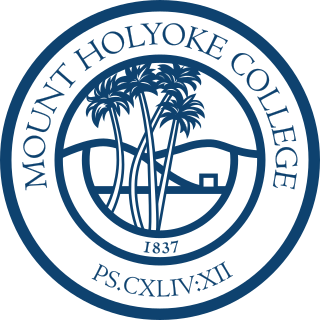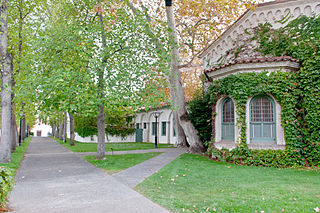
Amherst College is a private liberal arts college in Amherst, Massachusetts. Founded in 1821 as an attempt to relocate Williams College by its then-president Zephaniah Swift Moore, Amherst is the third oldest institution of higher education in Massachusetts. The institution was named after the town, which in turn had been named after Jeffery, Lord Amherst, Commander-in-Chief of British forces of North America during the French and Indian War. Originally established as a men's college, Amherst became coeducational in 1975.

Mount Holyoke College is a private liberal arts women's college in South Hadley, Massachusetts. It is the oldest member of the historic Seven Sisters colleges, a group of historically female colleges in the Northeastern United States. The college was founded in 1837 as the Mount Holyoke Female Seminary by Mary Lyon, a pioneer in education for women. Mount Holyoke is part of the Five College Consortium in Western Massachusetts.

Mount Holyoke, a traprock mountain, elevation 935 feet (285 m), is the westernmost peak of the Holyoke Range and part of the 100-mile (160 km) Metacomet Ridge. The mountain is located in the Connecticut River Valley of western Massachusetts, and is the namesake of nearby Mount Holyoke College. The mountain is located in the towns of Hadley and South Hadley, Massachusetts. It is known for its historic summit house, auto road, scenic vistas, and biodiversity. The mountain is crossed by the 110-mile (180 km) Metacomet-Monadnock Trail and numerous shorter trails. Mount Holyoke is the home of J.A. Skinner State Park which is accessible from Route 47 in Hadley, Massachusetts.

The Five College Consortium comprises four liberal arts colleges and one university in the Connecticut River Pioneer Valley of Western Massachusetts: Amherst College, Hampshire College, Mount Holyoke College, Smith College, and the University of Massachusetts Amherst, totaling approximately 38,000 students. They are geographically close to one another and are linked by frequent bus service which operates between the campuses during the school year.


Smith College is a private liberal arts women's college in Northampton, Massachusetts. It was chartered in 1871 by Sophia Smith and opened in 1875. It is the largest member of the historic Seven Sisters colleges, a group of women's colleges in the Northeastern United States. Smith is also a member of the Five College Consortium, along with four other nearby institutions in the Pioneer Valley: Mount Holyoke College, Amherst College, Hampshire College, and the University of Massachusetts Amherst; students of each college are allowed to attend classes at any other member institution. On campus are Smith's Museum of Art and Botanic Garden, the latter designed by Frederick Law Olmsted.

The University of Massachusetts Amherst is a public land-grant research university in Amherst, Massachusetts. It is the oldest, largest, and flagship campus in the University of Massachusetts system, and was founded in 1863 as an agricultural college. It is also a member of the Five College Consortium, along with four other colleges in the Pioneer Valley.
The Seven Sisters are a group of seven liberal arts colleges in the Northeastern United States that are historically women's colleges: Barnard College, Bryn Mawr College, Mount Holyoke College, Smith College, and Wellesley College are still women's colleges. Vassar College is currently a coeducational college and Radcliffe College was absorbed in 1999 by Harvard College.

Mary Mason Lyon was an American pioneer in women's education. She established the Wheaton Female Seminary in Norton, Massachusetts, in 1834. She then established Mount Holyoke Female Seminary in South Hadley, Massachusetts, in 1837 and served as its first president for 12 years. Lyon's vision fused intellectual challenge and moral purpose. She valued socioeconomic diversity and endeavored to make the seminary affordable for students of modest means.

Hidden Ivies is a college educational guide with the most recent edition, The Hidden Ivies, 3rd Edition: 63 of America's Top Liberal Arts Colleges and Universities, published in 2016, by Howard and Matthew Greene.
The Consortium on Financing Higher Education (COFHE) is an organization of thirty-nine private colleges and universities. Formed in the mid-1970s, COFHE is an unincorporated, voluntary, institutionally-supported organization of 39 highly selective, private liberal arts colleges and universities, all of which are committed to meeting the full demonstrated financial need of admitted students.

Women's colleges in the United States are private single-sex U.S. institutions of higher education that only admit female students. They are often liberal arts colleges. There were approximately 26 active women's colleges in the United States in 2022, down from a peak of 281 such colleges in the 1960s.
The Consortium of Liberal Arts Colleges (CLAC) is a nonprofit organization of 75 American liberal arts colleges which formed in 1984 under the leadership of Oberlin College's president S. Frederick Starr. CLAC brings together the IT professionals from its member colleges and universities to help those institutions make the best use of technology to enrich students’ learning, facilitate teaching and research, and to support the business of the higher education. CLAC has been supporting collaboration, knowledge sharing, professional growth of its IT members, and advocacy for the liberal arts at the national level for more three decades.

The Holyoke Range or Mount Holyoke Range is a traprock mountain range located in the Connecticut River Valley of Massachusetts. It is a sub-range of the narrow, linear Metacomet Ridge that extends from Long Island Sound near New Haven, Connecticut north through the Connecticut River Valley of Massachusetts to the Vermont border. A popular hiking destination, the range is known for its anomalous east–west orientation, high ledges and its scenic character. It is also notable for its unique microclimate ecosystems and rare plant communities, as well as significant historic sites, such as the Mount Holyoke Summit House and the Horse Caves.

MathPath is a mathematics enrichment summer program for students ages 11–14. It is four weeks long, and moves to a different location each year. MathPath is visited by mathematicians such as John H. Conway and Francis Su. It was probably the original, and is still one of the few, international residential high-end summer camps exclusively for mathematics and exclusively for students of middle school age.

The Institute for Architecture & Urban Studies is a non-profit architecture studio and think tank located in Manhattan, New York, United States. The original Institute existed from 1967 to 1984, where it was a hub for experimental architectural discourse and practice. It re-opened in 2003 as a non-profit offering individualized summer architecture studios.

The Orchard Hill Observatory is an astronomical observatory located at the highest point on the University of Massachusetts Amherst campus. Constructed in 1965, the observatory is a red brick building with a 16-inch Cassegrain reflector optical telescope. It is used for several community events and is regularly open for public viewing on Thursday nights. Originally the observatory was home to a 20" telescope, given to the department by an avid amateur who lived in central Massachusetts. It was a 1/10 scale model (loosely) of a larger 200" scope. Eventually, a crack was spotted during one of the re-aluminizings of the 20" mirror and the scope was no more. In the meantime, the department had been granted money associated with its move from Hasbrouck to the Grad Research Tower to buy a small telescope and put in on top of the GRC. The GRC had a small "isolation" pad built on its roof, which was supposed to be a mount for the scope, which could be accessed via a small open elevator. However, the GRC had terrible noise and gross vibration problems. The isolation pad never worked and there were too many safety concerns about using the roof of the building for observing. A 16" telescope was later bought from Competition Associates. That scope arrived in 1976 but because of the problems with using the top of the GRC, the scope was never mounted there. In fact, it sat in the basement of Hasbrouck for perhaps 10 years, becoming known as the "Subterranean Telescope". This situation finally led to the 20" being disassembled and the 16" scope being moved to Orchard Hill and installed in the dome there. The 16" was a major improvement in usability. As to what happened to the 20", the mirror may have been stored in the Astronomy Research Facility but the drive was most likely not kept.
The Associated Kyoto Program (AKP) is an independent study abroad program for undergraduate students located in Kyoto, Japan on the Doshisha University campus. It is a non-profit organization that is sponsored by 13 schools: Amherst College, Bates College, Bucknell University, Carleton College, Colby College, Connecticut College, Mount Holyoke College, Oberlin College, Pomona College, Smith College, Wesleyan University, Williams College, and Whitman College. Program of study includes Japanese Language courses and electives focused on Japan’s cultural history.














